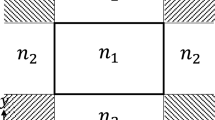Abstract
A comparative study has been performed between the finite difference time domain technique and the time domain beam propagation method (TD-BPM) while assessing the ultra short pulsed beam propagation inside dispersive power splitter. The dispersive GaAs material, used in the device, is modeled by Lorentzian dispersion relation that satisfies the refractive index of the material at a certain wavelength and shows a strong dispersion over a wide wavelength range. A smarter moving window technique is needed to be applied rather than at pulse’s group velocity for the TD-BPM, especially for bifurcated opto-electronic devices at the ultra short pulse.







Similar content being viewed by others
References
Adachi, S.: Properties of semiconductor alloys, group-IV, III–V, and II–VI semiconductors, p. 317. Wiley, New York (2009)
Akond, M.S., AlWadie, A., Masoudi, H.M.: Modeling femtosecond pulses in optical power splitter using time domain techniques. Opt. Quant. Electron. (2016). https://doi.org/10.1007/s11082-015-0354-4
Goorjian, P.M., Taflove, A.: Direct time integration of Maxwells equations in nonlinear dispersive media for propagation and scattering of femtosecond electromagnetic solitons. Opt. Lett. 17, 180–182 (1992)
Masoudi, H.: A novel nonparaxial time-domain beam-propagation method for modeling ultrashort pulses in optical structures. J. Lightwave Technol. 25, 3175–3184 (2007)
Masoudi, H., Akond, M.: Efficient iterative time-domain beam propagation methods for ultra short pulse propagation: analysis and assessment. J. Lightwave Technol. 29, 2475–2481 (2011)
Masoudi, H.M., AlSunaidi, M.A., Arnold, J.M.: Efficient time-domain beam propagation method for modeling integrated optical devices. J. Lightwave Technol. 19–5, 759–771 (2001)
Milinazzo, F.A., Zala, C.A., Brooke, G.H.: Rational square-root approximations for parabolic equation algorithms. J. Acoust. Soc. Am. 101, 760–766 (1997)
Mitchell, A.R., Griffiths, D.F.: The Finite Difference Method in Partial Difference Equations, pp. 198–199. Wiley, Hoboken (1980)
Tan, E.L.: Fundamental schemes for efficient unconditionally stable implicit finite-difference time-domain methods. IEEE Trans. Antennas Propag. 56(1), 170–177 (2008)
Tao, S.H., Fang, Q., Song, J.F., Yu, M.B., Lo, G.Q., Kwong, D.L.: Cascade wide-angle Y-junction 1\(\times\) 16 optical power splitter based on silicon wire waveguides on silicon-on-insulator. Opt. Exp. 16, 21456–21461 (2008)
Teixeira, F.L.: Time-domain finite-difference and finite-element methods for Maxwell equations in complex media. IEEE Trans. Antennas Propag. 56(8), 2150–2166 (2008)
Yee, K.S.: Numerical solution of initial boundary value problems involving Maxwells equations in isotropic media. IEEE Trans. Antennas Propag. 14, 302–307 (1966)
Yu, Y., Chen, Z.: Towards the development of an unconditionally stable time-domain meshless method. IEEE Trans. Microw. Theory Tech. 58(3), 578–586 (2010)
Zheng, F., Chen, Z., Zhang, J.: Toward the development of a three-dimensional unconditionally stable finite-difference time-domain method. IEEE Trans. Microw. Theory Tech. 48–9, 1550–1558 (2000)
Acknowledgements
This work is financially supported by Najran University Research Project Number NU/ESCI/14/039. The author extend his acknowledgment to the center of scientific research, Najran University. Special thanks to Nurul Alam for his valuable suggestions.
Author information
Authors and Affiliations
Corresponding author
Rights and permissions
About this article
Cite this article
Akond, M.S. Dispersive optical power splitter: assessment through time domain techniques. Opt Quant Electron 50, 221 (2018). https://doi.org/10.1007/s11082-018-1492-2
Received:
Accepted:
Published:
DOI: https://doi.org/10.1007/s11082-018-1492-2




